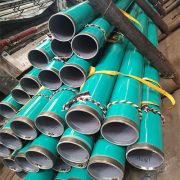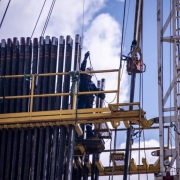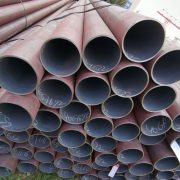Why Do We Use Steel Line Pipes to Transport Oil and Gas?
In the oil and gas industry, the safe and efficient transport of hydrocarbons from production sites to refineries and distribution centers is critical. Steel line pipes have become the material of choice for transporting oil and gas over vast distances, through challenging environments, and under extreme conditions. This blog delves into the reasons why steel line pipes are widely used for this purpose, exploring their key properties, advantages, and how they meet the demanding requirements of the oil and gas sector.
1. Introduction to Steel Line Pipes
Steel line pipes are cylindrical tubes made from carbon steel or other alloyed steels, specifically designed for transporting oil, natural gas, and other fluids in long-distance pipelines. These pipes must endure high pressures, extreme temperatures, and corrosive environments, making steel the ideal material for such applications.
Types of Steel Line Pipes:
- Carbon Steel Line Pipes: Commonly used due to their strength, durability, and cost-effectiveness.
- Alloy Steel Line Pipes: Used in more demanding environments, with added alloys like chromium or molybdenum for enhanced performance.
- Stainless Steel Line Pipes: Offer excellent corrosion resistance, particularly in harsh environments.
2. Why Steel Line Pipes Are Preferred for Oil and Gas Transportation
Steel line pipes have several advantages that make them ideal for transporting oil and gas. Below are the primary reasons why the industry relies on steel for pipeline infrastructure.
2.1. Strength and Durability
Steel has unmatched strength and durability compared to alternative materials. Oil and gas pipelines need to withstand high internal pressures as well as external environmental factors such as soil movement, heavy loads, and even seismic activity. Steel’s high tensile strength ensures that the pipes can endure these forces without cracking, bursting, or deforming.
2.2. Corrosion Resistance
Oil and gas are often transported through corrosive environments, such as salty coastal regions, offshore platforms, or pipelines buried underground where moisture and chemicals can accelerate corrosion. Steel line pipes are manufactured with protective coatings like 3LPE (Three-Layer Polyethylene) or Fusion Bonded Epoxy (FBE) to enhance corrosion resistance. Alloyed and stainless steels provide intrinsic protection in highly corrosive environments.
2.3. High Temperature and Pressure Resistance
Pipelines carrying oil and gas frequently operate at elevated temperatures and pressures, especially in deep-water or underground pipelines where conditions are extreme. Steel has a high melting point and excellent heat resistance, enabling it to handle the high-pressure and high-temperature conditions without compromising structural integrity.
2.4. Cost Efficiency
While steel may not always be the cheapest material, it offers excellent lifecycle cost benefits. Steel line pipes are known for their longevity, reducing the need for frequent repairs and replacements. Additionally, the strength of steel enables manufacturers to produce thinner pipes with the same pressure rating, reducing material costs without sacrificing performance.
2.5. Ease of Fabrication and Installation
Steel is relatively easy to fabricate, allowing manufacturers to produce pipes in a wide range of sizes, lengths, and wall thicknesses to meet project-specific requirements. Steel pipes can be welded, rolled, or bent to fit complex pipeline routes, and can be produced in large quantities, making them highly adaptable for both onshore and offshore installations.
2.6. Leak Prevention and Safety
Steel pipes, especially those manufactured to stringent industry standards (such as API 5L for oil and gas pipelines), have superior resistance to leakage. The seamless or high-quality welded construction of steel line pipes minimizes weak points where leaks could occur. In addition, steel pipes can withstand harsh environmental conditions and mechanical damage, which reduces the likelihood of accidental spills or explosions.
3. Key Concerns Addressed by Steel Line Pipes
The oil and gas industry has several specific concerns regarding pipeline infrastructure, many of which are effectively addressed by using steel line pipes.
3.1. Corrosion Management
One of the most significant challenges for pipelines, particularly those buried underground or used offshore, is corrosion. Even though the external environment may be highly corrosive, the internal fluids, such as sour gas (H2S-rich natural gas), can also corrode pipelines. Steel line pipes combat this with advanced coatings, cathodic protection systems, and by using alloyed steels that resist chemical reactions, ensuring long-term protection and reliability.
3.2. Environmental Impact and Regulations
Environmental concerns, such as oil spills and gas leaks, can have devastating effects on ecosystems. Steel line pipes meet stringent environmental regulations due to their strength, durability, and ability to prevent leaks. These pipelines are often subjected to rigorous testing, including hydrostatic and X-ray tests, to ensure structural integrity. Many steel pipe systems also include real-time monitoring for early detection of leaks, helping mitigate environmental risks.
3.3. Operational Efficiency and Maintenance
Steel’s durability and ability to resist both external and internal forces minimize downtime and maintenance needs. With pipelines often spanning hundreds of miles, frequent repairs are impractical. Steel line pipes require less frequent maintenance and have a longer lifespan than other materials, providing higher operational efficiency and lower long-term costs for pipeline operators.
4. Steel Line Pipes and Industry Standards
The oil and gas industry is heavily regulated to ensure the safety, reliability, and environmental protection of pipeline systems. Steel line pipes are manufactured according to various standards to meet these stringent requirements.
Key Standards:
- API 5L: Governs the manufacturing of steel line pipes for oil and natural gas transportation. It specifies material grades, sizes, and testing requirements to ensure the pipes can handle the pressures and environmental conditions of oil and gas pipelines.
- ISO 3183: An international standard that outlines similar specifications as API 5L but focuses on pipeline materials and coatings for global applications.
- ASTM A106: A standard for seamless carbon steel pipes used in high-temperature services, particularly in refineries and processing plants.
Adhering to these standards ensures that steel line pipes perform safely and effectively in the most demanding applications.
5. Advantages of Steel Line Pipes Over Alternative Materials
While other materials like polyethylene, PVC, or composite pipes may be used in low-pressure or small-diameter pipelines, steel remains the superior choice for large-scale oil and gas transport. Here’s why:
- Higher Pressure Tolerance: Alternative materials typically cannot withstand the same high pressures as steel, making them unsuitable for long-distance transport of oil and gas.
- Greater Temperature Resistance: Steel’s ability to endure extreme temperatures is unmatched by plastic or composite materials, which may become brittle or deform.
- Longer Lifespan: Steel line pipes have an extended service life, often exceeding 50 years when properly maintained, while alternative materials may degrade more rapidly.
- Recyclability: Steel is fully recyclable, which aligns with industry efforts to reduce environmental impact and promote sustainability.
6. Conclusion
Steel line pipes are indispensable in the oil and gas industry due to their exceptional strength, durability, corrosion resistance, and ability to withstand high-pressure and high-temperature environments. From the challenges of transporting oil and gas across vast distances to meeting stringent environmental and safety standards, steel line pipes have proven themselves as the most reliable and efficient option for pipeline infrastructure.
By choosing steel line pipes, oil and gas companies can achieve safer, more cost-effective, and long-lasting pipeline systems, ensuring the secure transportation of vital resources across the globe. The resilience and adaptability of steel continue to make it the material of choice for the industry’s ever-evolving needs.







